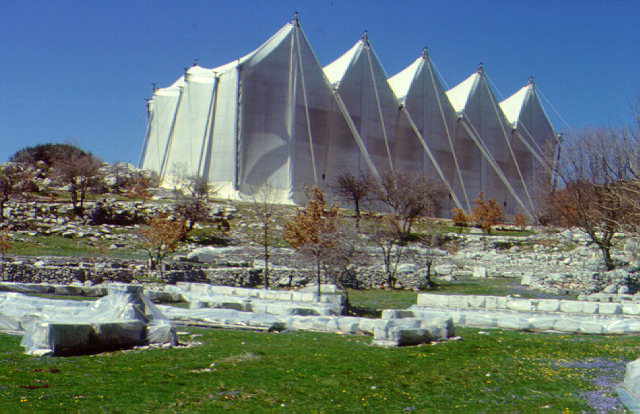
BIG 923
Presently/Actuellement |
Would be/Serait |
Official name / Dénomination officielle |
Altitude |
AGIOU N.VLASSIAS (950m) |
DELETED/ELIMINEE |
APOLLO EPIKOURIOS |
1130m |

Vallée de Vourakos dans le versant nord-est du Vlassias
ANALYSE / ANALYSIS
DESCRIPTION
Certes, la région est peu visitée, les paysages sont beaux, surtout par la vallée de Vourakos à l'est mais le sommet ne semble pas optimum et ressemble plus à un plateau qu'à autre chose.
Certainly is the region few visited, are the lascapes beautiful, above all through the Vouraos valley at the eastern side but the top doesn't seem a must and is more like a plateau than another thing.
LOCATION'S DIFFICULTY - DIFFICULTE DE LOCALISATION
C'est la difficulté. Aucune carte précise pour notifier le point le plus élevé.
It's the difficulty. No precise map to locate the highest point.
NAME'S DIFFICULTY - DIFFICULTE DE DENOMINATION
L'église est l'Agios Nikolaou Vlassias mais n'est peut-être pas le somemt. Il existe beaucoup de villages alentour avec le nom "Vlassia".
The church is the Agios Nikolaou Vlassias but is perhaps not the top. There are many villages around with the name "Vlassia".
CHOICE'S DIFFICULTY - DIFFICULTE DE CHOIX
C'est difficile. On aime bien la route mais le sommet manque d'intérêt.
It's difficult. We like the road but the top hasn't any interest.
TAKING PLACE's SUGGESTION - SUGGESTION DE REMPLACEMENT
APOLLO EPIKOURIOS
Le temple d'Apollo Epikourios est situé à une altitude de 1130m sur le mont Kotilio, 14km au sud d'Andritsaina. Sur ce site, appelé Bassai (petite vallée) dans l'Antiquité, les habitants du très proche Phigaleia fondèrent un sanctuaire à Apollo Bassitas au 7e siècle av.J-Christ, en lui adjoignant l'épithète Epikourios - accompagnateur dans la guerre ou la maladie. Le temple d'Apollo dans le sanctuaire de Bassai est un des monuments les mieux préservés de l'ancien monde classique. Bâti entre 420et 400 av.J-Christ, sur le site d'un temple plus archaïque, sa grande originalité réside dans le fait de son design intérieur. Dans la pièce, il y a une succession de colonnades sur trois des quatre côtés, comme au Parthénon ou à Hehaistos (de Theseion) à Athènes. Le temple est construit sur du limon avec du marbre pour la pièce centrale, le plafond et les décorations sculpturales. Tombant en ruine à l'ère romaine, d'abord pour cause humaine, ensuite par la dégradation naturelle due au temsp, le temple est actuellement protégé dans sa forme intiale après les travaux de restauration de la sciété archéologique au début du XXe siècle. Depuis 1965, et systématiquement depuis 1982, le ministère de la culture a entrepris la tâche délicate de protéger le monument. Une couverture plastique protège les matériaux des conditions hivernales, on rénove de manière anti-sismique et les autres installations actuelles sont temporaires et seront enlevées quand tous les travaux intérieurs seront parachevés.
The temple of Apollo Epikourios stands at a height of 1130m on Mount Kotilio, 14km south of Andritsaina. At this site, which was called Bassai (little valleys) in antiquity, the inhabitants of nearby Phigaleia founded a sanctuary of Apollo Bassitas in the 7th c. BC, where they worshipped the god with the epithet Epikourios - supporter in war or illness. The temple of Apollo in the sanctuary at Bassai is one of the best-preserved monuments of the ancient Classical world. It was built from 420 to 400 BC on the site of an earlier, Archaic temple. The great originality of the monument lies in its internal design. In the cella, there is a suggestion of a collonade on three of the four sides, as in the Parthenon and the temple of Hephaistos (the Theseion) in Athens. The temple is built of local limestone, with marble being used for the capitals in the cella, some parts of the ceiling and roof, and sculptural decoration. It began to fall into ruins in Roman times, initially because of human actions and later as a result of earthquakes. Today the temple is preserved in the form it received after the restoration work carried out by the Archaeological Society at the beginning of the century. Since 1965, and systematically since 1982, the Ministry of Culture has undertaken the difficult task of conserving and protecting the monument. The canopy that protects the sensitive building material from the extreme weather conditions in the region, the seismic-resistant scaffolding, and the other installations are all temporary, and will be removed once the rescue work is completed.



URL
http://www.worldheritagesite.org/sites/apolloepicurius.html